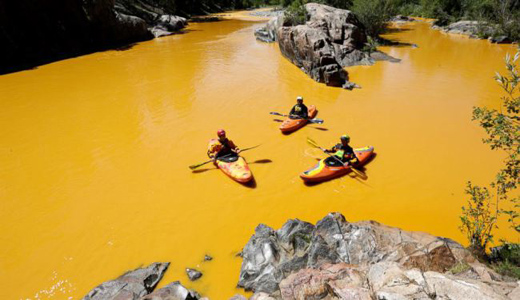
The latest ecological disaster has left Colorado’s Animas River a sickly orange and yellow, after an accident on Aug. 5 sent at least three million gallons of mine waste gushing into the water. The spewage came from the abandoned Gold King Mine, and occurred when an EPA mining safety team used equipment to – ironically enough – reduce pollution emanating from the disused site. Now the sludge is spreading, and it reached New Mexico on Aug. 10, flowing from the Animas into the San Juan River there, as officials struggled to gain control of the situation.
The wastewater contains toxic heavy metals including lead, which can harm fetal development and cause vision impairment and kidney disease, and arsenic, which at high levels could cause paralysis, blindness, and cancer. The contamination was apparently the very thing EPA workers were attempting to treat before inadvertently unleashing it upon the environment. “The project was intended to pump and treat the water and reduce metals pollution flowing out of the [Gold King] Mine,” EPA spokesman Rich Mylott confirmed.
There has been no drinking water contamination, because utilities shut down their intake valves in time to prevent the plume from reaching their systems. Farmers also closed the gates on their irrigation ditches to preserve their crops. But the same could not be said for the wildlife that will surely be adversely affected, including local fish; the EPA has warned boaters and anglers to stay far away from the water for this reason.
Meanwhile, New Mexico health officials were outraged that the EPA did not tell them about the plume until a day after it reached the cities of Aztec and Bloomfield, causing a last-minute scramble to cut off the river’s access to water treatment plants in those areas. As it is, the EPA has released very little information, and virtually nothing in the way of updates, concerning New Mexico’s share of the problem.
“We’re having a real problem getting the EPA to tell us what’s in this stuff,” said Don Cooper, emergency manager for San Juan County. “We’re just kind of shooting in the dark and telling people to stay away from it.”
Though EPA officials are reportedly continuing to conduct tests to determine the health and environmental impacts of their mistake, nothing has yet been said about a cleanup. In fact, it would seem that experts are hoping for the situation to resolve itself; the agency’s coordinator Craig Myers said, “It’s hard to know what’s going to happen [to the Animas River] as more river flows join it. It is diluting. The sludge of contaminants is going to be settling out in places.”
But for affected residents and concerned environmentalists, pollution, sadly, is more readily available than answers. What is apparent is that the EPA’s initial estimate of the amount of spillage – one million gallons – has proven to be wrong, as the U.S. Geological Survey has clarified that the incident sent at least two million gallons more into the Animas.
Kim Stevens, director of advocacy group Environment Colorado, remarked, “This is a really devastating spill. We’ve been hearing from rafting companies and other businesses that rely on the river that if they can’t get their clients out on the river in the next couple of days, they may have to shut down their doors.”
And then, of course, there’s the impact to the livelihoods of fishermen to consider. She added, “The fish population is especially very sensitive to water contamination, and we really won’t be able to see what the impacts are until all of the pollution has run its course. Time will tell.”
The poisoned water also runs through sensitive indigenous peoples’ territory, and the Navajo Nation people have said they will not stand for the toxification of their land. Nation president Russell Begaye stated, “They’re not going to get away with this. The EPA was right in the middle of the disaster and we intend to make sure the Navajo Nation recovers every dollar it spends cleaning up this mess and every dollar it loses as a result of injuries to our precious natural resources.”
And things are only going to get worse, at least in the short term, because the next stop on the mine waste’s tainted tour is Utah. The orange and yellow wastewater is still wending its way through the San Juan River, which eventually joins Lake Powell over in the Beehive State. Officials in the adjacent town of Montezuma are making preparations by shutting off water pumps there, and the same is being done in the neighboring town of Aneth. Trouble, of a most toxic variety, is most certainly brewing.
“There are people who want to know, ‘Okay, what’s going to happen now? Are you going to fix this?’ ” said Michele Truby-Tillen, a spokesperson for New Mexico’s San Juan County Office of Emergency Management. And above all, she said, as health concerns worsen, one question nags at the backs of people’s minds: “How are we going to protect our families?”
Photo: In an image so shocking one might think it’s Photoshopped, people kayak in the yellowed, poisoned Animas River on Aug. 6, in the midst of the effects of the massive wastewater spill. | Jerry McBride/AP & The Durango Herald

MOST POPULAR TODAY


Communist Karol Cariola elected president of Chile’s legislature

Zionist organizations leading campaign to stop ceasefire resolutions in D.C. area

Afghanistan’s socialist years: The promising future killed off by U.S. imperialism

High Court essentially bans demonstrations, freedom of assembly in Deep South






Comments